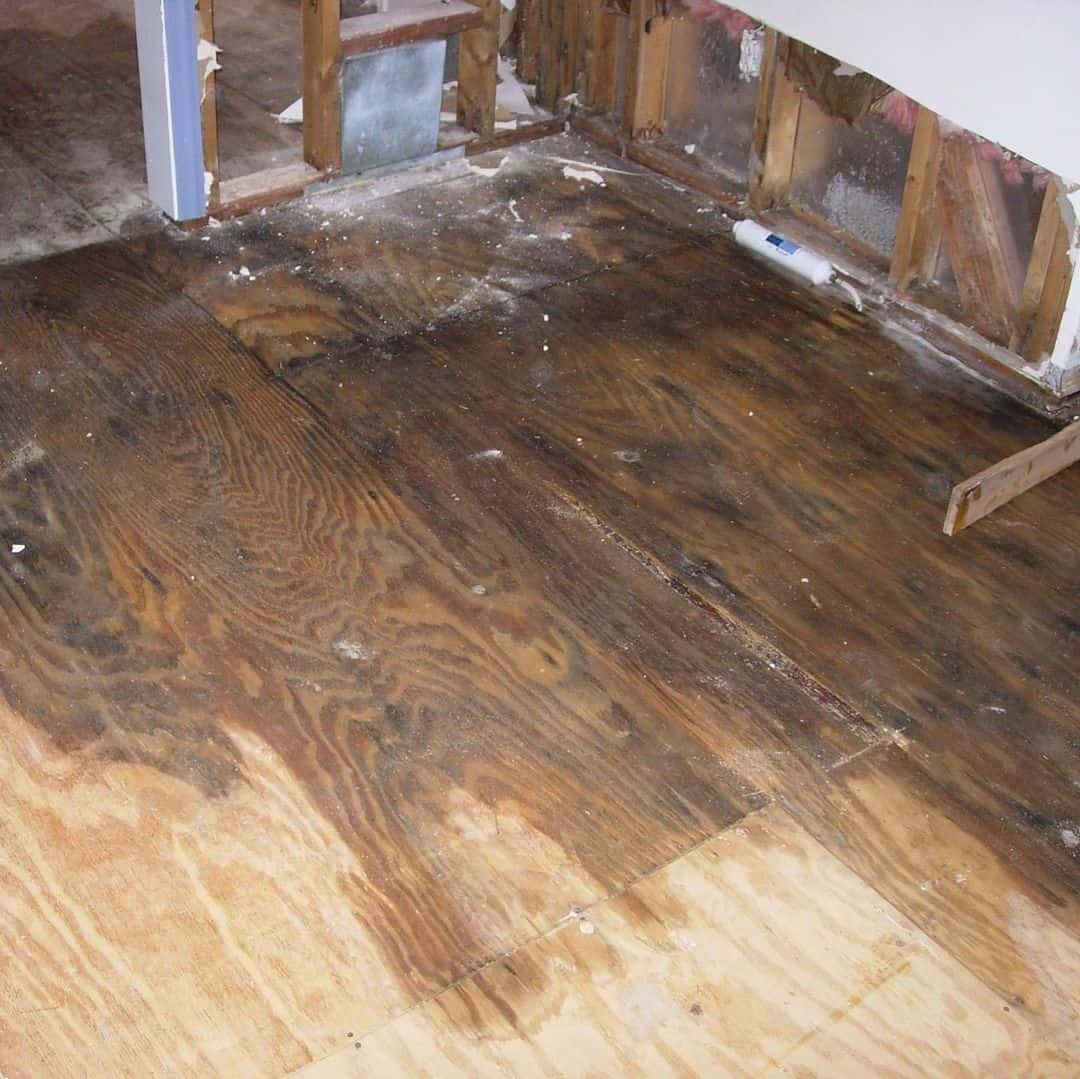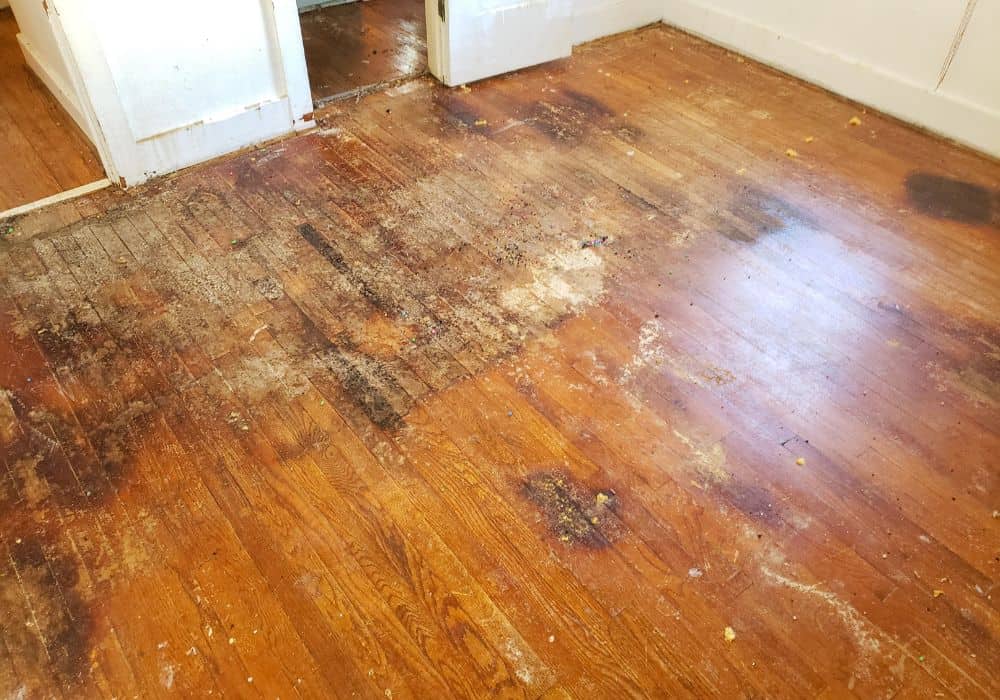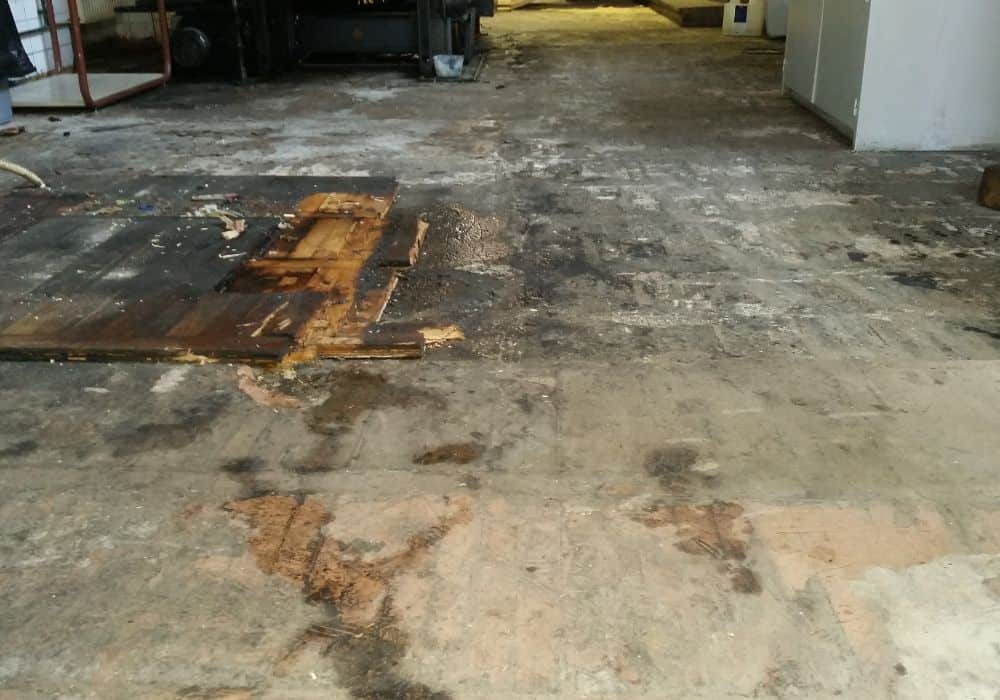It’s a real pain to get water leaks in your home, but even more so when it damages the floors, especially wooden flooring. We understand that this can be a frustrating experience and a serious issue that can ruin your home, but now it doesn’t have to be.
In this guide, we’ll walk you through how to fix water damage on wood floors so that you can get back to enjoying walking around your home with ease and peace of mind as soon as possible.
Table of Contents
Prepare Your Tools
To fix water damage on wood floors, you will need to take stock of the required tools before diving into the repair process, so you don’t get stuck in the middle of it with missing supplies! Having these items handy ensures your project is successful and completed efficiently.
- Moisture meter (optional)
- Vacuum or a mop
- Fans or a dehumidifier
- Clean cloths, rags, squeegee
- Fine-grit sandpaper
- Stain and sealer
- Safety goggles and dust mask (for sanding)
- Wood filler or wood patching compound
How To Fix Water Damage On Wood Floors: Step By Step Guide
Be sure to act fast when fixing water damage on wood floors. The longer you wait, the more damage it will leave, which may be challenging to repair. Once you get all the tools and equipment needed, it’s time to prepare yourself to do a little bit of work. Follow this step-by-step guide on how to fix water damage on wood floors.
Step 1: Inspect the Damage
The first step on how to repair water damage on wood floors is to inspect it. Look for visual cues such as warping, staining, or discoloration. Thoroughly inspect the entire floor, including the edges and corners, where damage is more likely to occur. You can also use a moisture meter to check the moisture content of the wood to ensure that it is not too high.
Crowning, buckling, staining, and cupping are the common types of water damage that can occur to wood floors.

When the center of the floorboard is more elevated than the edges, it is referred to as crowning, which is often caused by an uneven subfloor. To remedy this issue, the subfloor needs to be leveled, and the boards need to be sanded or planed down to level them out.
Buckling is when the boards’ warp and swell from the subfloor, caused by excessive moisture and warping of the subfloor. This can happen to both laminate flooring and solid hardwood flooring. To solve this, the source of the moisture needs to be identified and eliminated. The subfloor needs to be dried out and leveled. The boards may also need to be replaced.
Staining is when the wood takes on a dark, discolored appearance caused by water seeping into the planks. Black stains indicate severe damage, often resulting from prolonged moisture exposure leading to mold or mildew growth. Removing the stains can be challenging and may require sanding or replacing the affected wood to fully restore it.
Tips: You can use white vinegar with warm water to remove the dark stains and the odor.
Cupping is when the board’s edges are higher than the middle, caused by excess moisture. The affected panels should be removed and replaced.
Step 2. Find the Source of Water Damage
To prevent further damage to the flooring, it is important to locate the source of water damage after identifying the type. Possible sources include burst pipes, roof, flood, or high humidity within the home. Don’t forget to check appliances that may leak, like the refrigerator and dishwasher. Locating the origin of the water damage is essential as it is necessary to repair it in order to stop any additional harm to the flooring.
Conduct a thorough examination of the room and its surrounding areas to identify any indications of leaks or moisture. Inspect any potential water accumulation locations near windows or doors for any signs of leaks.
Step 3. Repair or Replacement
To figure out if you need to fix or replace your floors, you need to look at how bad the water damage is. You can probably fix it if it’s just in a small spot. But if the damage is all over the place and has hurt a lot of boards or the layer under the floor, you might need to get a new board. It is important to consider the cost, time, and effort of both options and to make the best decision for your situation.
Pro Tips: If the water damage is only surface level, try using a wood filler to fill in the cracks and then sand it down until it’s smooth, so you don’t have to replace the entire flooring.
Step 4: Fix the Problem
- Remove the Water Leak
On how to fix water damage on wood floors, the first thing you should do is get rid of all the water. After rinsing with clean water and mild detergent, you can use a mop or shop vacuum on wet mode a mop to get rid of as much water as you can. Once you have removed most of the surface water, check for signs of mold and remove it with a disinfectant cleaner like TSP (trisodium phosphate).
- Dry the Floor
Once all the water and dirt have been removed, the floor needs to be completely dried. This can be done by using fans or a dehumidifier. The fans or dehumidifier should be placed in the affected area and left running until the floor is completely dry. Ensure that the floor is completely dry before proceeding to the next step.
- Scrape and Scrub
Once the floor is dry, the next step is to sand the floor. This is done to remove any damaged or discolored wood. The sanding process will also help to smooth out any rough or uneven areas on the floor. Use fine-grit sandpaper to avoid damaging the floor further.
- Seal the Floor
The final step in fixing the water-damaged wood floor is to seal the floor. This is done to provide additional floor protection from future water damage. The sealer will help to prevent water from penetrating the wood and causing further damage.
It is important to ensure that the sealer is applied evenly and according to the manufacturer’s instructions—two thin layers of a water-based sealant should do the trick!
Extended Tips
To keep your wooden floors looking great, keep an eye out for any signs of water damage. Here are a few more tips to help protect your wooden floors:
1. What to Avoid
- Excessive water. Too much water when cleaning the floor can cause the floor to warp or buckle.
- Use of harsh chemicals or abrasive cleaners. These can damage the finish and make the floor more susceptible to water damage.
- Walking on the wet floor. Not only is this dangerous and prone to slippery, but this can also cause the floor to warp or buckle.
- Carpet installation. Installing carpet or other floorings over a damaged wooden floor can trap moisture and cause further damage.
- Delaying repairs. The longer you wait to fix water damage, the more extensive and costly the repairs will be.
2. Prevention of Water Damage on Floors
- Keep your floors dry. Make sure to immediately wipe up any spills or runoff, and use mats, rugs, and runners to ensure that excess water from shoes and rain doesn’t seep in.
- Repair problems. You should also repair any plumbing problems or leaks as soon as possible.
- Check for molds. Regularly check for mildew or mold growth and take care of them quickly. That way, you can keep your wood floors looking brand new for years to come.
- Have good air circulation. Ensure your house is properly insulated and ventilated to prevent any moisture buildup, especially in bathrooms or laundry rooms where humidity levels can be especially high.
FAQs on How to Fix Water Damage on Your Wood Floors
You might have some questions about repairing water damage on your wood floors, so let’s take a moment to answer some of the most common ones.
Q1: Can I repair the water damage myself?
Yes, it is possible to repair water damage on your own. However, it may be wise to enlist the help of a professional to ensure that everything is done correctly and safely. They can also assess the extent of the damage and recommend any necessary repairs or restorations that may be needed.
Q2: How much will it cost?
The cost of repairing water damage will vary depending on the severity of the issue and any additional repairs or restorations that may be needed. The Uptown website has an estimated calculation of $65 to $100 per hour. But it’s best to consult with an expert near your area for more accurate estimates.
Conclusion
By following our guide, you will be able to have an idea of how to fix water damage on wood floors to restore them to their original condition.
Always use caution when working with water—even a small amount can cause significant damage. For more home repair guides, follow us or comment with a suggestion of what you want to read in the future.

